
How To Keep Your Ford Engine Running Smoothly
Your Ford Ranger is more than just a vehicle. It’s a companion for both the everyday city drive and the adventurous off-road excursion. To keep

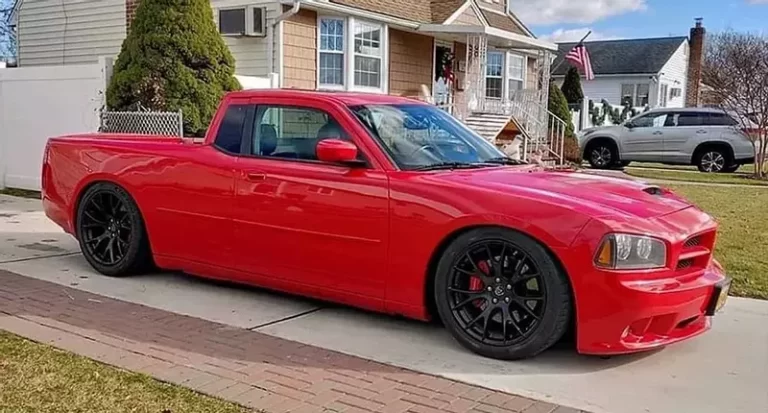
Part 1 – The Dodge Charger Pickup Conversion
Think of a kit car as a grown-up’s Lego set with about 400 steps to completion. Plus you get to use power tools!
The motivation for building your own kit car stems from three benefits:
The first is, you get to build something with your own hands. Remember though, building your own car is a lot of work. It is a big undertaking that can be overwhelming if you’re not prepared. Fortunately, kits and cars help make the job go as smoothly as possible. They provide parts you would otherwise have to fabricate yourself, lists of tools needed, and detailed instructions. (Most providers now also include full, step-by-step explainer videos.)
The second is, you’ll save an absurd amount of money over just buying a new car, plus you can spread out your investment in the build over time. Most kit cars are designed to be built in stages. If you want power but can’t afford the upgrades today, you can start with a stock motor and swap it out later for a better engine.
The third benefit is that you will learn a lot along the way, especially how not to do things. The key here is to take your time. There’s no countdown clock. Also, practicing the “measure twice, cut once” rule will save a lot of frustration as you find your sea legs.
Kit cars are commonly sold as a set of parts, which the buyer assembles into a functioning vehicle. Almost always, they are built around a “donor” vehicle, which will likely include the engine, transmission, and sometimes a chassis from a regular production vehicle. Often buying a crashed vehicle, with a crumpled body but an undamaged frame, will work, and save you a lot of money, predicated on the essential mechanical components being in working order.
When done right, a kit car can become a wholly-customized jaw-dropper, for a fraction of the price of the genuine article, while still offering the reliability that the donor vehicles’ contemporary engineering provides.
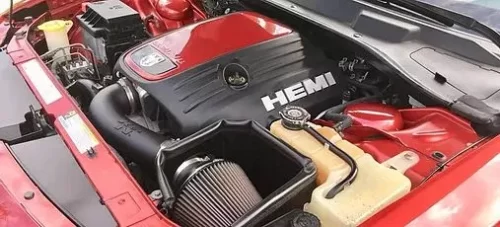
The first in our series is the Smyth Charger Pickup conversion.
(SmythKitCars.com)Think of it as a modern El Camino built by converting a Dodge Charger donor car.
You start with any 4-door Dodge Charger from 2005-2010. (Yep, this muscle car came in a 4-door.)
You buy Smyth’s conversion kit, and when the 460 lbs., 8-foot by 3-foot by 2-foot crate is delivered to your closest UPS freight terminal, you’re on your way. (You will have to get it to your build location yourself.) Luckily, the rear window and the steel tailgate are delivered directly to you in a separate, special package to prevent damage.
While we can get into the specifics of how conversion is done, we feel this set of how-to videos will give you an exhilarating glimpse of what is ahead of you:
(Smyth Charger-to-Pickup Conversion Process Videos)Seems doable, (to any red-blooded American,) but if you have no car-tinkering experience whatsoever, we strongly recommend you tackle this endeavor with a gear-head friend by your side.
As you saw in the video, the conversion is pretty straightforward, starting with the disassembly of portions of the donor car. This is followed by a very satisfying cutting and removal of specific body parts. While you do remove half of the roof, and the top of the rear quarter panels, all structural members remain intact, from the front of the car all the way to the rear bumper. Since you only modify the upper rear section of the car, the stock engine is left untouched and fully functional.
Once the “stripping” is complete, adding the kit parts consists of drilling strategically-located holes and bolting or riveting new fabrications to your existing chassis.
Amazingly, the Smyth (no-welding) conversion is actually stronger than the original chassis. According to Smyth’s website, the Smyth design was the result of over two years of engineering work to reinforce the rear of the donor car for use as a light-duty truck. When the builder is done bolting and riveting all the panels in place, the resulting truck is stronger than the original car. Assembly of the kit utilizes proven race car and airplane technology, which incorporates extensive use of structural rivets and bolts.
After many thousands of miles in heavy-duty use, the Smyth shop truck, which regularly tows a 2,000 lb. trailer, (and is more often over-loaded,) still performs as solidly as the day it rolled out of the garage.
Finally, you delve into the world of Bondo and paint, which we strongly recommend you engage the assistance of an experienced friend or professional to complete. As attention to detail in this stage produces the most noticeable results or problems.
This particular kit car conversion, (for fairly-capable people,) will take between 20 to 40 hours.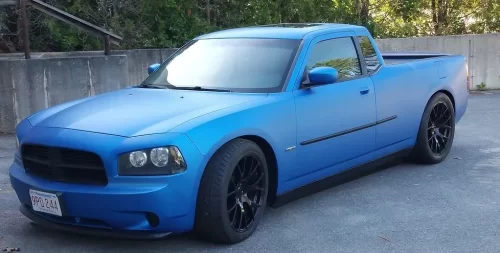
First, you need to know that Smyth incorporates 30+ years of race car building into the design of their conversion kits, and they are meticulous. It all starts with a very finite selection of “donor” vehicles, which must meet a very stringent list of requirements.
Generally, a unibody car uses the rear pillar of the roof as part of the structural strength of the chassis. All conversions vehicles Smyth selects as templates are built with strong 4″ to 8″ subframe chassis rails, which bear the majority of the load on the car. Even when cutting and removing the rear roof pillar extensions, the vehicle is still left with a stronger-than-average chassis, that was reinforced at the factory to begin with.
The Dodge Charger is a very tough car, with all of these features, so it makes a great foundation for a conversion.
Additionally, Smyth only has to replace the strength lost in the small sheet metal area behind the back door. Instead of using thin steel, stamped and spot welded in place, they use very thick aluminum plates and put double-wall door filler panels in place of the rear doors. This engineering work makes a design that transfers the load of the removed rear pillar extension evenly from the roof with a thick vertical plate just behind the front door.
This reinforces the load path and greatly improves loading strength and torsional (twisting) rigidity.
The new front wall of the bed that mounts just behind the driver, also drastically solidifies torsional rigidity while increasing side impact strength. That wall, now a full foot behind the front seats, absorbs impacts to the other side pillars as well as the floor. The double side walls of the bed and door filler plates are used to transfer heavy truck loads evenly throughout the chassis.
As an added safety feature, the Smyth conversion truck has no second-row passenger seating. This adds almost three feet to the crumple zone in the rear of the vehicle, affording a total of almost seven feet of crash-absorbing distance. Smyth car-to-truck conversions retain the entire floorplan and all the heavy-duty lower frame members of the donor cars. They even keep the rear factory high-strength steel bumper assembly under the roll pan.
While possibly considered overkill, this design is purposeful because, after all, they are converting cars to trucks. And inevitably, people are going to overload their vehicles, so Smyth ensures a tough and safe platform for truck use. Your finished conversion will drive with the performance of the original Dodge Charger, and the utility of a solid pickup truck.
Aside from finding your perfect donor Charger, the cost of this Smyth car/truck conversion kit is just $2,990.
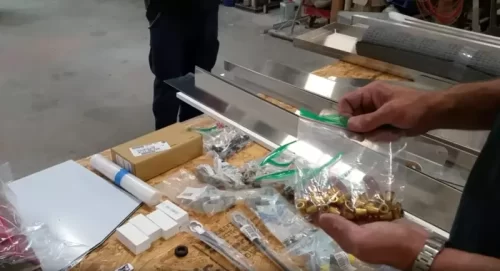

Your Ford Ranger is more than just a vehicle. It’s a companion for both the everyday city drive and the adventurous off-road excursion. To keep

Issue 39 • Engine & Transmission Tips The battery-less vehicle jump starter is revolutionary, super-safe, and it works! You walk out to your car one
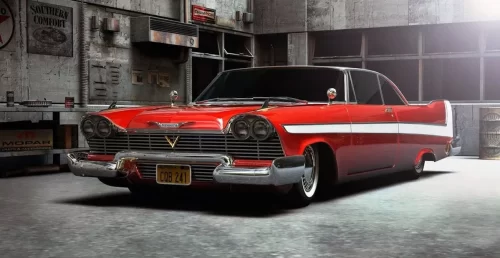
She’ll love you, possess you, and then destroy you. Enjoy this first installment of “Scary Cars”, our October series Set in 1978, Christine chronicles how a possessed
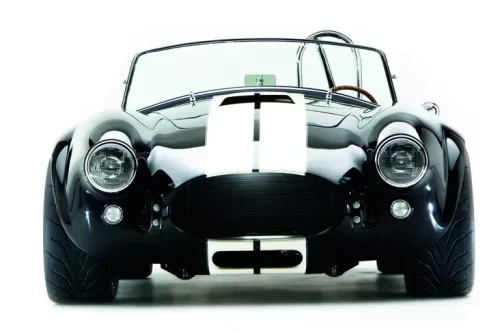
Part 2 – The Factory Five Mk4 Roadster This kit car is a dead-on replicate of a 1965 Shelby Cobra Project: 1965 Shelby Cobra Replica

Starring a 1964 Buick Skylark Convertible that didn’t do it! Mint green? Positraction? Temptests? Who is this four-wheeled star? My Cousin Vinny is a 1992

The 1992 Ford Explorer XLT Debuted In Jurassic Park Legendary. Not for its engine, but for its paint job! To be honest, the Ford Explorer